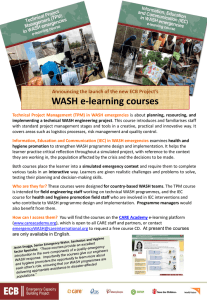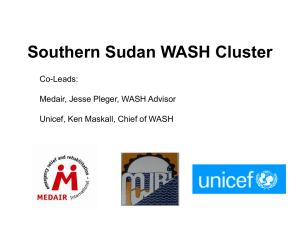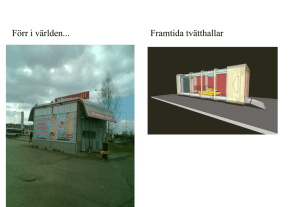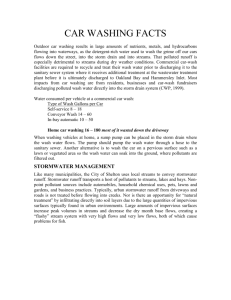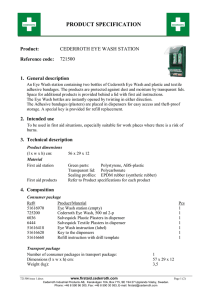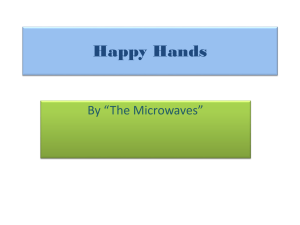Car Washing - Clean Water Minnesota
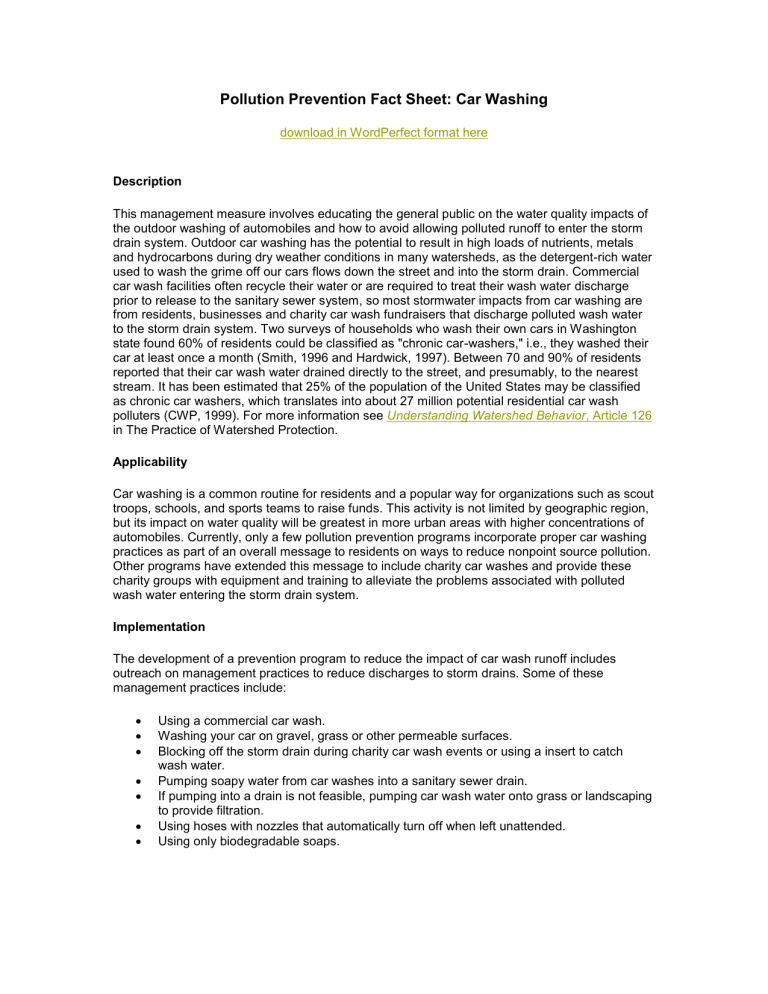
Pollution Prevention Fact Sheet: Car Washing
download in WordPerfect format here
Description
This management measure involves educating the general public on the water quality impacts of the outdoor washing of automobiles and how to avoid allowing polluted runoff to enter the storm drain system. Outdoor car washing has the potential to result in high loads of nutrients, metals and hydrocarbons during dry weather conditions in many watersheds, as the detergent-rich water used to wash the grime off our cars flows down the street and into the storm drain. Commercial car wash facilities often recycle their water or are required to treat their wash water discharge prior to release to the sanitary sewer system, so most stormwater impacts from car washing are from residents, businesses and charity car wash fundraisers that discharge polluted wash water to the storm drain system. Two surveys of households who wash their own cars in Washington state found 60% of residents could be classified as "chronic car-washers," i.e., they washed their car at least once a month (Smith, 1996 and Hardwick, 1997). Between 70 and 90% of residents reported that their car wash water drained directly to the street, and presumably, to the nearest stream. It has been estimated that 25% of the population of the United States may be classified as chronic car washers, which translates into about 27 million potential residential car wash polluters (CWP, 1999). For more information see Understanding Watershed Behavior , Article 126 in The Practice of Watershed Protection.
Applicability
Car washing is a common routine for residents and a popular way for organizations such as scout troops, schools, and sports teams to raise funds. This activity is not limited by geographic region, but its impact on water quality will be greatest in more urban areas with higher concentrations of automobiles. Currently, only a few pollution prevention programs incorporate proper car washing practices as part of an overall message to residents on ways to reduce nonpoint source pollution.
Other programs have extended this message to include charity car washes and provide these charity groups with equipment and training to alleviate the problems associated with polluted wash water entering the storm drain system.
Implementation
The development of a prevention program to reduce the impact of car wash runoff includes outreach on management practices to reduce discharges to storm drains. Some of these management practices include:
Using a commercial car wash.
Washing your car on gravel, grass or other permeable surfaces.
Blocking off the storm drain during charity car wash events or using a insert to catch wash water.
Pumping soapy water from car washes into a sanitary sewer drain.
If pumping into a drain is not feasible, pumping car wash water onto grass or landscaping to provide filtration.
Using hoses with nozzles that automatically turn off when left unattended.
Using only biodegradable soaps.
Storm drain stenciling programs emphasize the connection between the storm drain system and runoff and help reinforce that car washing activities can have an affect on local water quality.
In the Pacific Northwest, outreach programs provide materials to charity car wash organizers to prevent car wash water from entering storm drains. These "water friendly"car wash kits are provided free of charge to charity organizers along with training and educational videos on planning an environmentally friendly car wash. Two types of equipment are available for charity organizations to borrow; a catch-basin insert with a sump pump or a vacuum/boom device known as a Bubble Buster (Kitsap County, 1999). Both devices capture wash water runoff, allowing it to be pumped to either a sanitary sewer or a vegetated area for treatment.
For businesses, good housekeeping practices can minimize the risk of contamination from wash water discharges. Table 1 gives some general best management practices that those businesses that have their own vehicle washing facilities can incorporate to control the water quality impacts of wash water discharges.
Table 1. Stormwater Management Practices for Car Washing
Facilities
1. Have all vehicle washing done in areas designed to collect and hold the wash and rinse water or effluent generated. Recycle, collect or treat wash water effluent prior to discharge to the sanitary sewer system.
2. Pressure cleaning and steam cleaning should be done off-site to avoid generating runoff with high pollutant concentrations. If done onsite, no pressure cleaning and steam cleaning should be done in areas designated as wellhead protection areas for public water supply.
3. Map on-site storm drain locations to avoid discharges to the storm drain system.
4. Immediately contain and treat spills.
Limitations
The biggest limitation to implementing residential car wash best management practices may be the lack of knowledge regarding the impacts of polluted runoff. Many people do not associate the effects of their vehicle washing activities with local water quality, and may be unaware that the discharges that enter storm drains are not treated at plants before being discharged into local waters.
Surveys indicate that the average citizen does not fully understand the hydrologic connection between their yard, the street, the storm sewer and the streams. For example, a recent Roper survey found that just 22% of Americans know that stormwater runoff is the most common source of pollution of streams, rivers, and oceans (NEETF, 1999).
Most car washing best management practices are inexpensive, and rely more on good housekeeping practices (where vehicles are washed, planning for the collection of wash water) than on expensive technology. However, the construction of a specialized area for vehicle washing can be expensive for businesses. Also, for facilities that cannot recycle their wash water
the cost of pretreating wash water through either structural practices or planning for collection and hauling of contaminated water to sewage treatment plants can represent a cost limitation.
Effectiveness
The effectiveness of car washing management practices at reducing nonpoint source pollutant loads has yet to be measured accurately. Due to the diffuse nature of nonpoint source pollution, it is often difficult to determine the exact impact of a particular pollution prevention measure at reducing pollutant loading. While not much is known about the water quality of car wash water, it is very clear that car washing is a common watershed behavior. Three recent surveys have asked residents where and how frequently they wash their cars (Table 2).
Study
Smith, 1996
Maryland
Table 2. Summary of Car Washing Surveys
Car Washing Behavior
60% washed car more than once a month
Pellegrin,
1998
California
73% washed their own cars
73% report that wash water drains to pavement
Hardwick,
1997
Washington
56% washed their own cars
44% used commercial car wash
91% report that wash water drains to pavement
56% washed car more than once a month
50% would shift if given discounts or free commercial car washes
Residents are typically not aware of the water quality consequences of car washing, and do not understand the chemical content of the soaps and detergents they use. Car washing is a very difficult watershed behavior to change since it is often hard to define a better alternative.
However, as with all pollution prevention measures, the reduction of pollutant loads from outdoor car washing activities are bound to have a positive effect on stormwater quality.
Cost
Staffing and materials represent the largest expenditure for local governments seeking to administer a nonpoint source education program. Car wash outreach programs are relatively inexpensive to staff and often require only a limited outlay for materials (brochures, training videos, etc.), and staff time devoted specifically to car wash education can be less than five percent of an employee's time. For Kitsap County, Washington, the Sound Car Wash program requires roughly ten to fifteen hours a week of staff time over a twenty-five week period from April to September. Cost for materials and equipment replacement is estimated to be between $1,500 and $3,000 for the same twenty-five week period (Kitsap County, 1999). The Clean Bay Car
Wash kits program in Tacoma, Washington uses only the catch basin insert option and estimates that its spends no more than $2,000 per year and less than two weeks of staff time per year to handle requests for its program (City of Tacoma Stormwater Utility, 1999).
The purchase of wash water containment equipment is often a one-time expense and this equipment is often used for a number of years. Two pieces of equipment used in car wash programs developed in the Pacific Northwest provide an example of the potential equipment cost.
For the catch basin insert, the approximate cost of installation is $65. In some cases, locations
where charity car washes are frequently held have constructed their own catch basin inserts using plywood. For the Bubble Buster, the cost ranges from $2,000 to $2,500.
References
Camp Dresser & McKee (CDM), et al.
1993. California Storm Water Industrial/Commercial Best
Management Practice Handbook . Stormwater Quality Task Force. Sacramento, CA.
Center for Watershed Protection (CWP). 1999. On Watershed Behavior. Watershed Protection
Techniques . 3(2).
City of Tacoma Stormwater Utility. 1999. Personal Communication . Tacoma, Washington.
Hardwick, N. 1997. Lake Sammamish watershed water quality survey . King County Water and
Land Resources Division. Seattle, WA. 122 pp.
Kitsap County Sound Car Wash Program. 1999.
Personal communication and webpage . Web site address: www.wa.gov/kitsap/departments/pubworks/carwash.html
Lance Winslow III. 1999. How to Run a Successful Car Wash Fundraiser . Car Wash Guys
International, Inc.
National Environmental Education Training Foundation (NEETF). 1999. National Report Card on
Environmental Knowledge, Attitudes and Behaviors: Seventh Annual Roper Survey of Adult
Americans . National Environmental Education Training Foundation. Washington, D.C.
Natural Resources Defense Council (NRDC). 1999. Stormwater Strategies: Community
Responses to Runoff Pollution . Natural Resources Defense Council, Inc. New York, NY.
Pellegrin Research Group. 1998. Stormwater/urban runoff public education program. Interim evaluation. Resident population . Los Angeles County Department of Public Works. 28 pp.
Smith, J. 1996. Public survey used to estimate pollutant loads in Maryland. Technical Note 73.
Watershed Protection Techniques . 2(2): 361-363.

